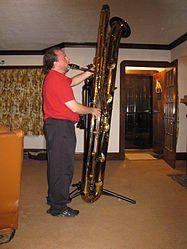 An Eppelsheim Full-size Subcontrabass Saxophone | |
| Classification | Aerophone |
|---|---|
| Playing range | |
| Written range In B♭: sounds three octaves and a major second lower than written. | |
| Related instruments | |
| Military band family:
Orchestral family:
Other saxophones:
| |
| Musicians | |
| More articles or information | |
The subcontrabass saxophone is a type of saxophone that Adolphe Sax patented and planned to build but never constructed. Sax called this imagined instrument saxophone bourdon (named after a low pitch stop found on many pipe organs). It is a transposing instrument pitched in B♭, one octave below the bass saxophone, two octaves below the tenor saxophone, and three octaves and a major second below its written pitch.
History
Until 1999, no genuine, playable subcontrabass saxophones were made, though at least two gigantic saxophones were built.[1] Although the smaller of the two (constructed in the mid-1960s) was able to produce musical tones, with assistants opening and closing its pads due to the instrument's lack of keywork, witnesses stated that it was incapable of playing even a simple scale.
The B♭ subcontrabass tubax,[2] which was developed in 1999 by instrument manufacturer Benedikt Eppelsheim of Munich, Germany, is described by Eppelsheim as a "subcontrabass saxophone". This instrument is available in both C and B♭, with the B♭ model providing the same pitch range as the saxophone bourdon would have. A contrabass-range tubax in E♭ is also available.
The question of whether or not the tubax is truly a saxophone is debatable: it has the same fingering as a contrabass saxophone, but its bore, though conical, is narrower (relative to its length) than that of a regular saxophone. This makes for a more compact instrument with a "reedier" and "fatter" timbre. While some argue that the tubax is akin to the double-reed sarrusophone, the tubax's bore is much larger than that of the corresponding size of sarrusophone. Since several conical single-reed instruments with bores narrower than the saxophone are known (Octavin, Tarogato, Heckelclarina), analogies to a double-reed instruments can only relate to range and overall dimensions. Some authorities regard the tubax as a separate family of instruments rather than as a type of saxophone.
A Brazilian company, J'Elle Stainer, produced a working compact subcontrabass in 2010, which was shown at Expomusic 2010.[3]
In September 2012, instrument manufacturer Benedikt Eppelsheim of Munich, Germany completed building the first full-size subcontrabass saxophone. This instrument stands 2.25 meters (7 feet 5 inches) tall.
In July 2013, J'Elle Stainer of Brazil completed building a 2.8-meter (9-foot-2-inch) full-size subcontrabass saxophone.[4]
See also
References
- ^ "Subcontrabass Saxophones (?)". Retrieved 2007-03-17.
- ^ "Tubax B♭ subcontrabass saxophone". Retrieved 2013-07-11.
- ^ http://www.below65-4hz.com/
- ^ Attilio Berni plays the giant J'Elle Stainer sub-contrabass saxophone, Attilio Berni, Moonlight big band, conductor: Augusto Travagliati, accessed 2020-02-01
External links
- of the first movement of "Duet for Basses" by Walter Hartley, played as a B♭ Tubax duet (one instrument, overdubbed), performed by Jay C. Easton
